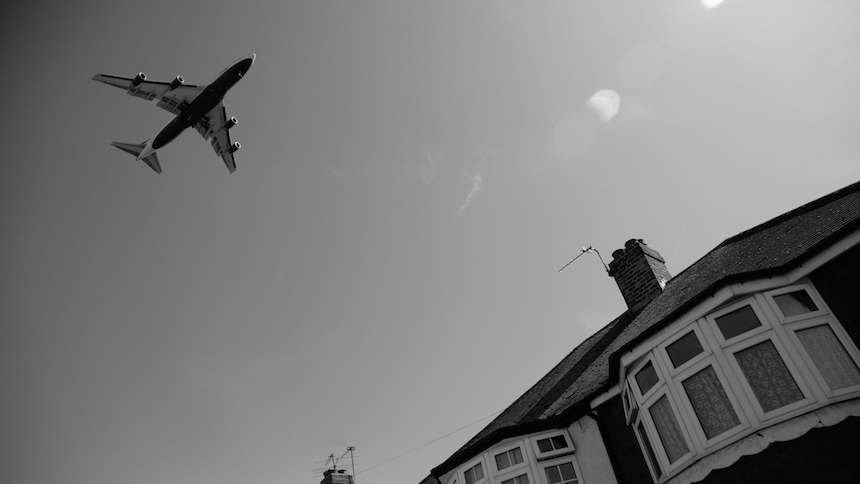
Teddington Action Group has questioned the necessity of low-flying aircraft from Heathrow and state that they are flying lower compared to other airports causing more noise, more suffering and more CO2 emissions than at almost any other airport in the World. Subsequently, it asks the question what impact this is having to those on the ground who are experiencing this increase in noise and its effects on health.
In a paper (full extract below) to all mayoral candidates as well as the Department for Transport, and the Environment Select Committee, TAG have analysed using tools used by Heathrow airport and NATS, which are recognised by the aviation industry to demonstrate how much lower and consequently noisier flights are in and out of Heathrow.
The paper asks that the Heathrow Noise Regulations issued in 2010 be tightened so as to require planes to climb from Heathrow at a rate of up to three times that which exists at present. This will bring Heathrow into line with other major international airports.
Are Low Flying Planes at Heathrow Causing Us Harm?
The answer is a resounding YES!
Planes using Heathrow have some of the lowest flying and lowest climbing rates of any airport in the world and as a result cause more noise pollution and more damaging climate changing gases than are necessary. A significant number of planes take off, climb to about 900’, then level off into a slower rate of climb for the next 5 miles before starting to climb again. Planes from Heathrow take off at a rate of climb that is significantly lower than the rates of climb at other airports in the world. This change together with new or different overflights happened almost overnight starting in June 2014, causing mayhem, damage and destruction of happiness to huge numbers of people. Complaints have soared by over 1,500%1 and numerous protest groups have sprung up. This is nothing to do with “NIMBYism”. The impetus for protest is because the Heathrow flight path changes have put people in a completely different position than before, without any discussion, compensation or indeed any explanation. The Aviation Environment Federation have described it as “One day, you wake up and overnight bulldozers have turned your road into a motorway with car after car rushing past your house.”2
There are required minimum rates of take-off at Heathrow set out in the Heathrow Airport London (Noise Abatement Requirements) Notice 2010. The requirements are that planes climb to 1,000 feet by 6.5 kilometres from the point at which they start their take off run or “start of roll”. Once they reach 6.5 kilometres from start of roll, aeroplanes are required to climb at a rate of not less than 4% or 1 in 25. The trouble is that these rates of climb are so low and out of date that even a World War II Lancaster Bomber fully loaded could make that.
We in the Teddington Action Group have taken details from both WebTrak and Flight Aware.3 WebTrak is preferred by Heathrow and following an audit from NLR Netherland Aerospace Centre is stated to be 99% accurate. However, WebTrak is not available at all airports. We have therefore used both sources.
There is a notable difference in the rate of climb for smaller aircraft out of Heathrow than larger aircraft. Steeper climbs give savings in fuel burn and consequently reduce CO2 emissions.4 However, the Civil Aviation Authority (“CAA”), charged with “the licensing of air transport, the licensing of the provision of accommodation in aircraft, the provision of air navigation services, the operation of aerodromes and the provision of assistance and information5” states that the servicing requirements are substantially increased if steep climbs are used.6 There is some thought, also expressed by the CAA that steeper rates of climb increase the emission of NOx, but this is likely to be marginal since the majority of NOx is emitted from vehicles on the ground.7
There are cost balances. The take-off time for a short haul flight to northern Europe is a relatively larger proportion of the total flight time compared to that of a long haul flight. It therefore makes commercial sense to take off quickly, save fuel and pay the extra servicing costs. For long haul, the take-off time represents a smaller proportion of total flight time. It therefore is more commercially economic to take off slowly, burn more fuel, pump more CO2 into the air and pay extra fuel charges while saving on the servicing costs of a shallow take-off.
According to Flight Aware Heathrow is right at the bottom of the league table. The list below compares the initial rates of climb by feet per minute achieved by large planes from airports after the first 900’ have been achieved:
- 777 out of Santiago 2,800’ per minute
- A380 out of Charles de Gaulle 2,082’ per minute
- 777 out of Buenos Aires 1,962’ per minute
- 747 out of Frankfurt 1,800’ per minute
- A380 out of JFK New York 1,612’ per minute
- 747-400 out of Santiago 1,385’ per minute
- A380 out of Amsterdam 1,000’ per minute
- A380 out of JFK New York 1,000 per minute
- A380 out of Heathrow 774’ per minute
Web Trak shows measurements as aircraft climb. Taking heights of planes measured through Web Trak at either 12 kms from start of roll or 9 kms from point of take-off8, the results again show Heathrow occupying the bottom position by a substantial margin:
- 777 out of Madrid 1,770 metres or 5,800’
- 738 out of Chicago 4,900’
- A320 out of Eindhoven 1,410 metres or 4,620’
- 788 out of Heathrow to Delhi 4,400’
- A340 out of Madrid 1290 metres or 4,230’
- 777 out of Chicago to Shanghai 3,900’
- A380 out of Madrid to Dubai 1,200 metres or 3,900’
- 747 out of Heathrow to Bombay 3,700’
- 747-400 out of Brussels 960 metres or 3,140’
- 777 out of Chicago 3,100’
- 767 out of Heathrow to Madrid 2,300’
- A380 out of Heathrow 2,200’
- 789 out of Heathrow to Johannesburg 1,900’
- A380 out of Heathrow 2,000’
- 747 out of Heathrow 1,800’
- 777 out of Heathrow to Houston 1,600’
Prior to May 2014, flights of heavier aircraft were much higher. We have recorded, again through Web Trak, some flights prior to the 31st May 2014 with an A380 to Dubai at 3,100’ at Swan Island, Twickenham (12 kilomteres from start of roll). A Boeing 747 to Kuala Lumpur was at 4,300’ at Swan Island and an A330 to Cairo was at 4,500’ at Swan Island. Heathrow conducted its own investigation by a company called PA Knowledge, which concluded that heights of planes on departure had reduced and showed one plane flying recently as low as 1,423’ by Swan Island.
The WebTrak data, post June 2014, is set out in the Sheet 1 graph below:
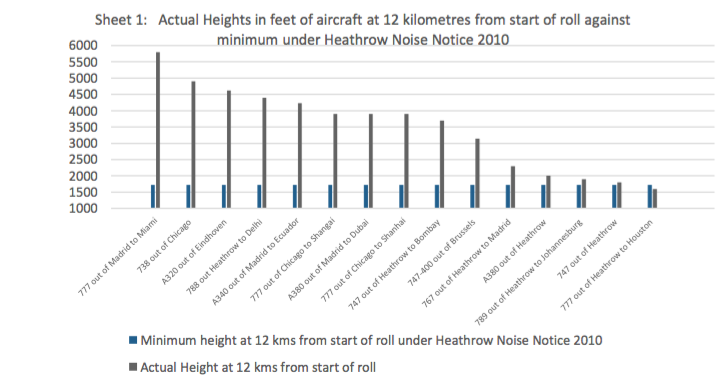
8.6% is the initial effective rate of climb required by the Heathrow Airport London (Noise Abatement Requirements) Notice 2010 in order to get to 1,000’ by 6.5 kilometres from start of roll. Taking this rate and the subsequent rate of 4% gives a net climb by 12 kilometres from start of roll of 5.8%. This rate of climb gets a plane to 1,720’ by 12 kilometres from start of roll, which is Swan Island / Teddington / Twickenham / Hampton area to the east and Windsor Castle, Englefield Green and Egham areas to the west. At this height planes are causing a huge amount of noise – enough to cause very serious annoyance. Sheet 2 below shows the planes in Sheet 1 by rates of climb. The steepest aircraft climb recorded was out of Madrid with a 777 to Miami which climbed to 5,800’ by 12 kilometres making a rate of climb of just under 20%. One of the few high climbing planes out of Heathrow was a 788 to Delhi that recorded a rate of 15%. By contrast an A380 managed a rate of 6.8%, a 747 one of 6.1% and a 777 one of 5.7%, the last not even making the required minimum, although it was the same type of plane that made the maximum rate of climb out of Madrid.
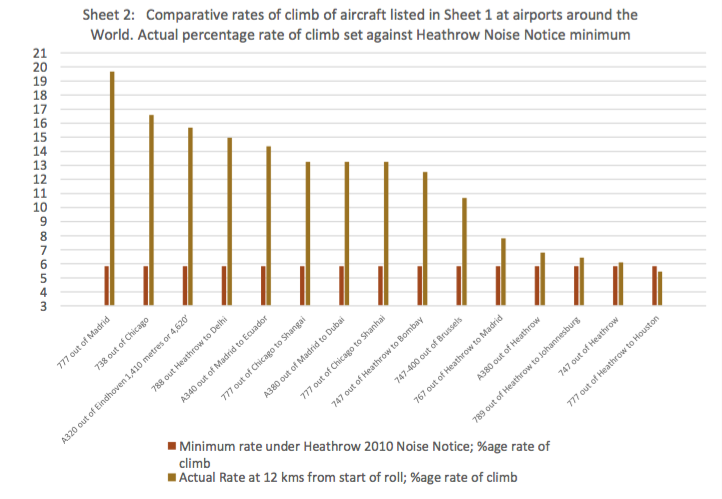
Research and modelling have been carried out to show that noise diminishes with distance and therefore height. It may seem logical that the farther away something emitting noise is, the less sound is suffered by the recipient. The same applies to height: the higher a plane, the lower the noise impact on the ground. Obviously the plane itself will not be making less noise but more of the plane’s noise will be absorbed into the airspace between it and the ground. In other words, the steeper the climb, the less disturbance for people under Heathrow take-off paths. This conclusion is confirmed by NATS who have carried out a noise modelling exercise to show the noise on the ground emitted by various types and sizes of planes.
Sheet 3 shows the noise emitted by the planes at various heights in accordance with the ANCON / NATS Noise modelling. The noisiest plane is the lowest flying and set at 78 decibels, which is the typical 747 / A380 reading at the NPL Noise Monitor. The noise is taken for all planes to be the amount emitted from a 747. Sheet 4 shows the decrease in decibels and loudness with the different plane heights compared with the two lowest planes departing out of Heathrow. It can be seen that by 12 kilometres from start of roll, a plane departing out of Heathrow and getting to a height of 4,000’ will make 10 decibels less noise at ground level than one getting to a height of 2,000’. The logarithmic nature of decibels means that a difference of 3 decibels equates to a doubling of noise. Two identical planes emitting 76 decibels between them will each be emitting 73 decibels. We can see from the Sheet 4 graph that the A340 out of Madrid is four and a half times less loud than the lowest planes leaving Heathrow – and there is no need for the Heathrow planes to be that low. There are also noise savings all the way along the flight path prior to the 12 kms point if planes are climbing more steeply.
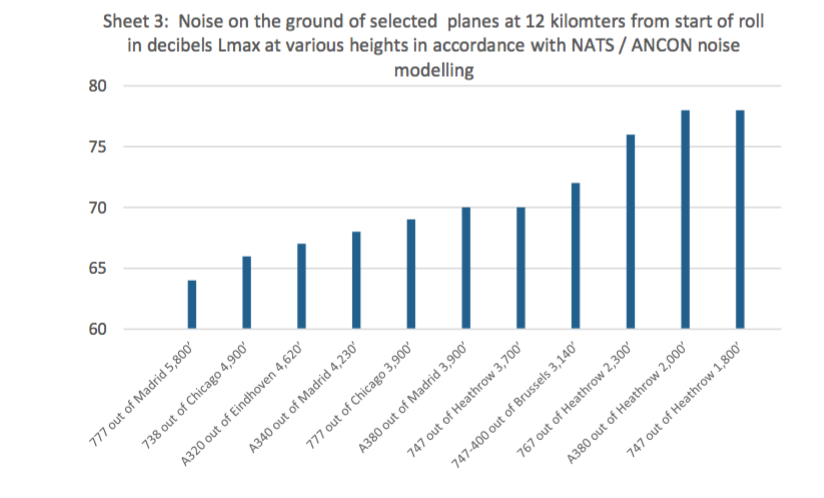
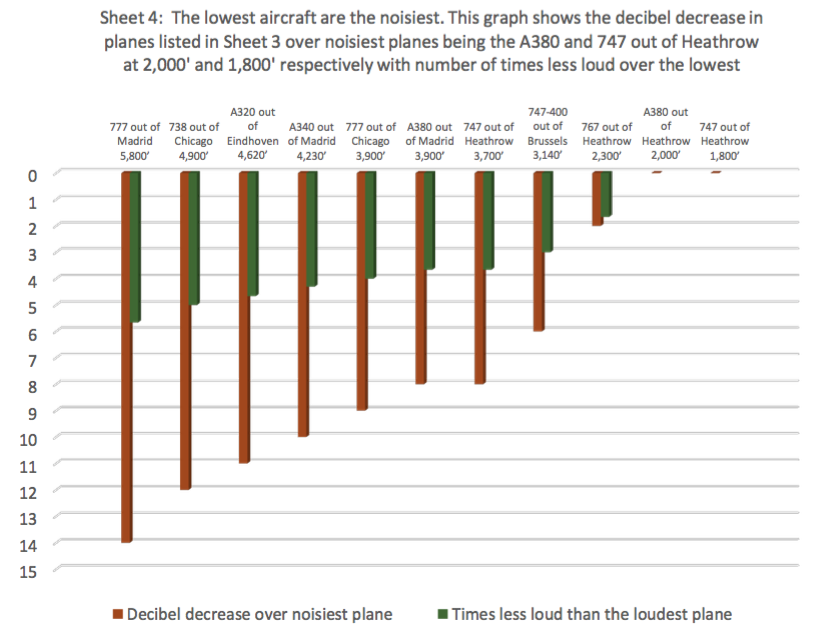
Sheet 5 shows the difference the other way round using the Madrid 777 as the baseline. So using the ANCON / NATS model the 747 travelling out of Heathrow at 1,800’ was five and a half time louder than the 777 leaving Madrid.
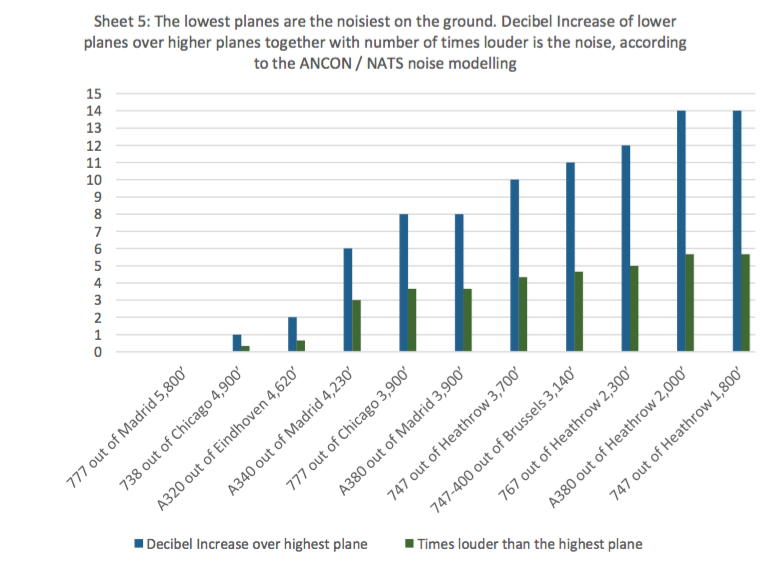
All the planes leaving Heathrow, apart possibly from one discussed below, can climb at a rate far in excess of the minimum required, which is out of date and simply being abused by the operators to increase profits at the expense of noise nuisance. People on the ground are being used as sacrificial lambs to pander to the airline industry’s desire to save on servicing costs.
Health Consequences
The health consequences of excessive noise have been well documented. Lack of sleep causes extensive harm and there are substantial learning deficiencies in children who have been exposed to excessive noise. Even the Airports Commission published evidence of this albeit after it had issued its Interim Report and only one month before its Final Report.9 The health costs from aircraft noise across the UK have been conservatively estimated to be in the region of £540 million each year and at least one million people’s health in the UK could be affected by aircraft noise10.
Cost Consequences
It is clear that Heathrow have not even scratched the surface on compensation to be paid to people suffering the consequences of Heathrow’s operations. The whole budgeting of the operation of the airport and proposals for expansion are based upon people just “putting up and shutting up”. Properties up to 30 miles away may need to be insulated because of the operations of Heathrow. The likely cost is £2 billion after the proposed expansion rather than the £700 million proposed by Heathrow11.
It would be perfectly possible for all planes (apart from possibly one to be discussed below) to meet substantially increased rates of climb. So:
What do we want to happen?
What needs to happen is for the Heathrow Airport London (Noise Abatement Requirements) Notice 2010 to be amended to provide:
- All aircraft must attain at least 2,500’ [up from 1,000’] by 6.5 kilometres from start of roll
- Thereafter all aircraft must keep climbing at a rate of at least 12% [up from 4%] until 6,000’ [up from 4,000’]
Unless this is done, planes will not revert to a proper rate of climb. Both the CAA and Heathrow have repeatedly said that they have no control over airlines on how they operate departure climb rates over the Noise Notice minimum (extraordinary as that may seem, if it is indeed true). Heathrow do not appear to oppose the principle of raising the minimum rate of climb saying of it “I think we’re all agreed [it] could be a positive step”.
From Sheet 2, it can be seen that all the large planes can manage, and do regularly manage, the suggested increased take off rate apart possibly from one, so there is nothing in this that cannot be done, with the one exception dealt with below. It is being regularly done at other international airports. Heathrow subjects more people to more noise than any other airport in the World. There is no reason why it should not meet proper standards of environmental cleanliness. The benefits of proper conduct to surrounding communities are enormous. It is not as if we are asking for anything new. All this was being done prior to June 2014.
It would stop the cost cutting abuse of the current system. Not only is the current system of low flying wreaking havoc amongst the communities on the ground, it is damaging to the climate by producing more CO2 than is necessary12 as well as impeding the diminution of climate change in accordance with our protocol obligations13. It is also contrary to the Government’s current stated policy of limiting and where possible reducing the number of people significantly affected by aircraft noise as is evidenced by the rise in complaints set out in the first paragraph above.
The aviation industry has long failed miserably to pay its way through taxation and to act responsibly within the environment. It is not going to be able to comply with the targets set out in the Kyoto Protocol or the Climate Change Act 2008. The Committee on Climate Change’s Fifth Carbon Budget report of November 2015 says with typical muted urgency that:
“Emissions from international aviation should continue to be allowed for by setting the budget on the path to meeting the 2050 target with international aviation emissions included. However, the accounting for these emissions remains uncertain, so they should not be formally included in the fifth carbon budget.” and
“Aviation. While UK demand for international aviation is likely to grow considerably, there will be a need to limit emissions. Previous analysis by the Committee concluded that aviation should plan for emissions in 2050 to be no higher than those in 2005. That requires strong efficiency improvements to balance demand growth of about 60%.”
Why does this Government deliberately allow planes to fly low, harm its population, damage the development of its children and needlessly pump extra CO2 into the atmosphere? Does it not take its obligations to reduce the harmful effects of excessive noise and its responsibilities for the reduction of climate change seriously?
Does the evidence show that all planes can make the proposed rates of climb?
Yes, it does from the above apart possibly from one plane. That one plane is the Airbus A380. It is our view that the A380 has been erroneously granted a noise Quota Count of 2 on departure and 0.5 on arrival15. That is half that of the older 747s and is supposed to indicate that at 2 versus 4, the A380 is half as loud as the 747. Experience and measurements have shown that it is anything but. It is a monstrously noisy plane that travels at low altitude on departure. How or why the A380 got past the authorities and got a noise quota count of 2 must remain conjecture at this stage – maybe misconduct is involved somewhere. One thing is for certain. It should never have been given a Noise Quota Count of 2 on departure and 0.5 on arrival. It is a noisy beast and should not enjoy the privileges associated with a Noise Quota Count of 2 on departure that allows it to fly at night out of Heathrow. The aircraft in its current form should be strictly limited in its operations at Heathrow, with no flying between 8pm and 8am.
Notes:
1 According to Heathrow 3,240 enquiries by way of complaint to Heathrow were made in the period January to June 2012 and 108,255 complaints to Heathrow were made in 2015
2 Huffington Post 23rd March 2016
3 See Glossary Terms at the end for definitions
4 CAA paper CAP1062
5 Civil Aviation Act 1982 section 3(b)
6 CAA paper CAP1165
7 See mitigating effects in Airports Commission final report paras 9.84 et sec and Jacobs Air Quality Assessment May 2015 para 5.4.3 et sec in which it is stated that the NOx “hot spot” is at the Bath Road
8 The assumption is that an aircraft will typically roll along the runway for 3 kilometres before actually lifting off the ground. Measurements can be taken from start of roll at one end of a runway or, in order to calculate the hypotenuse of a triangle to get the percentage rate of climb, from the assumed point of lift off. The 12 kilometre point from start of roll has been chosen since it equates with Swan Island / Twickenham / Teddington / Hampton
9 Queen Mary University – Aircraft noise effects on health Dr. Charlotte Clark. See also James Lees of the Airport Environment Federation in the Huffington Post and The Lancet to name but a few.
10 See Aviation Environment Federation
11 See HACAN estimate set out in the Richmond and Twickenham Times 25th March 2016
12 See ICAO Continuous Operations (CCO) Manual and also CAA document CAP 1062
13 Under the Kyoto Protocol as amended the UK is obliged to reduce carbon emissions to 80% of 1990 levels by 2020. Under the Climate Change Act 2008, the UK is obliged to reduce carbon emissions to 20% of 1990 levels by 2050. International aviation is excluded from the Climate Change Act but the Committee on Climate Change in its 5th Carbon Budget report states that emissions from international aviation should be provided for. The Paris Accord to be signed provides that signatory states, of which the UK is one, will strengthen “the global response to the threat of climate change, in the context of sustainable development and efforts to eradicate poverty, including by: Holding the increase in the global average temperature to well below 2 °C above pre-industrial levels and to pursue efforts to limit the temperature increase to 1.5 °C above pre-industrial levels, recognizing that this would significantly reduce the risks and impacts of climate change;”
14 Government’s Aviation Policy Framework 2013 para 17
15 Teddington Action Group has done research following disclosure, under the Freedom of Information Act, of noise Lmax records from a noise monitor on the top of the National Physical Laboratory in Teddington showing that records of noise events were being taken from planes flying not only on routes flying directly over the National Physical Laboratory but also on a route heavily used by A380s that is over 1 kilometre away from the Laboratory giving an artificially reduced noise reading for the A380. In addition, the CAA paper 1106 and ANCON / NATS Noise modelling shows that the A380 is no quieter than the 747. Also see NATS model at http://www.nats.aero/environment/aircraft-noise/representative-aircraft-lmax-data/

[…] Low flying around Heathrow is something on which we have been trying to get Heathrow to take action for over 6 years now. We wrote about this back in June 2016 […]
As a native New Yorker, I am aghast at your complete lying down and rolling over to all this- Yank airlines are the greediest, but the govt puts peoples health before money-order your corrupt bloody government to beat JFK and even a poorer country like Spain, has Madrid making you look like a bunch of cretins…
Your Conservative govt, as usual, (is Teddington MPs conservative? havent checked, but guess yes) states it is all out for reducing aircraft noise and emissions- well, TED HAS BEEN GOING FOR OVER HALF A DECADE AND GOT NOWHERE- TRY COMPLAINING TO YOUR LABOUR/LIB DEM MPs
I live in Teresa Mays (your ex Prime Minister) constituency, Windsor and Maidenhead, and aircraft at this distance from Heathrow should be invisible
not only are they flying well below cloudbase, they also look at times to be flying below the 1000 foot minimum from the very large cranes in the area
I ,with poor 63 year old eyesight can make out the tailcolours(mostly British Airways) and sometimes, can even make out the row of windows
its absolutely disgusting-skies above me were clear 5 years ago, when i moved here,, and they take several different routes around my skyline, so they appear to be ignoring official flightpaths, and flying wherever suits their pockets
My area now has a noise problem that
A- didnt exist 5 years ago
B- shouldnt exist now
I drove to Slough recently, and the aircraft heights were the same as when i briefly lived in the godforsaken hole that is Slough- stayed with a friend for 2 months whilst finding my place in Windsor, cannot believe the sound levels,sleep was a joke, and when warm and windows opened, it was insane, sitting in a beer garden, with your conversation drowned out every 30-40 seconds, poor sods….
This all happened during Conservative government, whilst supposedly under EU flight height minimum rules- now UK is out of EU, your only chance is if you
A- get off your backsides and protest
B- get a legal challenge started
I have loads of pictures and video, when I see someone actually doing something constructive, I will happily add my evidence to their cause.
Why dont you come to Windsor, and even further out ,my friends house in North town moor, Maidenhead- with a basic phone you will get superb video and photos- with a decent camera with some zoom, you would get the aircraft registration numbers,so I imagine a court case with this crystal clear evidence of noise/emissions contraventions would make a case quick and easy.
Or try sending your results to Teresa herself, and ask why her time as PM ,with promises of action, were false, and what she will do about it,as it is now affecting her constituency,very badly.
I am moving shortly, so i am not wasting my time joining a bunch of moaners, if I was staying, I would certainly be doing something about it.
I’d like more information to understand the operated climb rates. I noticed (quote) :
“Steeper climbs give savings in fuel burn and consequently reduce CO2 emissions.4 However, the Civil Aviation Authority (“CAA”), […] states that the servicing requirements are substantially increased if steep climbs are used.6”
Could you be more explicit about these statements ? It is not obvious to find this information in the source provided :
– the first one “4 CAA paper CAP1062” deals with “continuous climbs”, which is very different from “steeper climbs”
– the second one “6 CAA paper CAP1165” contains lot of information, if you could indicates what section you are referring to, it would be useful.
thanks
[…] The answer is likely to be engine maintenance costs and fuel consumption. By retracting flaps at 800’+, the air resistance is reduced and less fuel is consumed. Our lives under departure routes are being made a misery not because it is necessary for the good of others who need to travel but because of money savings to be had by the aviation industry. Not only that; the UK is unique in this level of suffering since our European friends insist on the recommended procedures being followed. Their planes climb at a far greater rate than out of Heathrow – see the Teddington Action Group article on our website (which can be viewed by clicking here). […]
Depending on the destinations, lost items will go through settlement procedures according to the respective conventions ratified by the two cities that the passenger is flying between.
Do your calculations take into account the point at which aircraft are starting their climb i.e. airport heights above sea level? Madrid 610m, Santiago 474m, Chicago 204m, Heathrow 25m.
Hi Peter, We believe that they do but further enquiries of Web Trak would be required. Flight Aware would take account of the starting point since their calculations are rate of climb rather than the starting altitude. The figures have been put to Heathrow some months back and they have not contradicted them.
TAG
This is very interesting and informative but one thing I haven’t understood is why airlines would choose to vary their rate of climb at different airports. Do other airports dictate the rate of climb, unlike Heathrow?
I was think thinking that too. Do they have different rules at different airports, maybe?
Again great work tag!!!! Thanks.